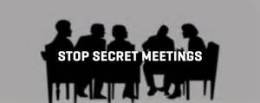We’ve all seen news reports of people getting death threats. Have you wondered what it’s like? Here’s one family’s experience. The names are fictitious; the events are not.
“A man called my home and threatened to kill my family, your honor. That made it personal… very personal.”
Barry Lawson was testifying at the trial of a man accused of threatening to murder his wife, their three children and then him.
The prosecutor told the jury that at the time Berry was the media contact for a large company embroiled in an acrimonious labor strike.

“The truth is, the strike was just an elaborate ruse,” the prosecutor added.
“As bizarre as it may seem, the real purpose of the strike was a secret plan to embarrass the company and the government. It was a misguided effort by union leaders to gain public support for a political party. The plan backfired.”
He said that leading up to the strike, union officials had misled members into believing the walkout was all about wages and benefits. The death threats came after Barry had exposed their plan in the news media, effectively turning the tables on the union officials.
The prosecutor told the court tensions had been running high as the strike dragged on. Weeks had turned into months with no resolution in sight. Incidents of violence on the picket lines were increasing as cash-strapped employees began returning to work.
Barry testified that after receiving several crank phone calls, recording devices had been installed to monitor phones in his office and home. All recordings were turned over to police.
Several examples of the crank phone calls were played in court, followed by the death threat. This is what the jury heard:
“Lawson, your wife and kids are dead meat!” an angry male voice shouted. “You hear me, you bastard? I’m gonna blow their fucking heads off, and I’m gonna to watch you suffer for a while! Then I’ll be coming after you, asshole!”
When the recording ended, silence descended on the courtroom. Police testimony earlier revealed that a search of the accused man’s house had uncovered a cache of illegal weapons and ammunition. They also found hand-drawn maps of Barry’s back yard and home.
“As you heard,” Barry testified, “the man’s voice on the recording was angry and determined. He left no doubt in my mind about his intentions. I couldn’t risk not believing him. This call was more than employees venting their frustration… that’s to be expected during a strike. This wasn’t one of those calls.”
“Please tell the jury what happened next,” the prosecutor said.
 Barry replied, “After I hung up, my wife Anne asked, ‘Who was that?’ It was obvious she’d been watching the expressions on my face while I was on the phone. I told her, ‘Oh, just a wrong number.’ It was a lie. I had never lied to her before. Then, she asked, ‘Are you okay?’ I could see she was worried; apparently I wasn’t doing a very good job of covering my anxiety. She had answered the phone a number of times during the strike and got some of the crank callers. Anne is a caring and very positive person, but strong willed and not easily upset. However this time, her eyes revealed a uncharacteristic fear.
Barry replied, “After I hung up, my wife Anne asked, ‘Who was that?’ It was obvious she’d been watching the expressions on my face while I was on the phone. I told her, ‘Oh, just a wrong number.’ It was a lie. I had never lied to her before. Then, she asked, ‘Are you okay?’ I could see she was worried; apparently I wasn’t doing a very good job of covering my anxiety. She had answered the phone a number of times during the strike and got some of the crank callers. Anne is a caring and very positive person, but strong willed and not easily upset. However this time, her eyes revealed a uncharacteristic fear.
“I told Anne I was tired, and said: ‘I’ve got some work to do.’ That was another lie.
“I went to our den and phoned the head of the company’s security. I explained what had happened. In a couple of hours armed guards were posted around our house. For the duration of the strike, teams of guards shadowed my wife to and from her office, our three children to and from school and their other activities, and me to and from work. The guards tried to be discrete, but sometimes it wasn’t possible.
“Anne objected. Understandably, their presence added to her worry and to the children’s fear. At first, I told them it was just a precaution. That was partly true and partly another lie. That’s when I realized she had every right to know about the death threats. I told her the truth.”
The prosecutor said: “Please tell the court what effect, if any, all of this had on your children and your family.”
“Our children sensed our fear,” Barry replied. “One evening after the guards had been assigned, I was tucking our youngest daughter into bed when she asked me, ‘Daddy, who are those men? Did we do… did I do something wrong?’
“The other two children also wanted to know why strange men seemed to be hovering around them all the time, and why they couldn’t play outside at home, or at school like the other kids during recess, or visit with friends after school and on weekends.
“Anne and I made excuses. We kept saying it was just a precaution. We didn’t want to frighten them more than they already were. The children weren’t fooled. Anne and I could see they knew that we weren’t telling them the truth. That’s the worst part. Our efforts to protect them was eroding their trust in us.”
Later outside court, Barry explained that in the weeks leading up to the walkout, union leaders had gained the ear of several top reporters with falsehoods about the company, just as they had misled their membership. Much of the news coverage had become decidedly pro-union.
After the strike began, union officials stepped up their false accusations about the company. The pro-union reporters dutifully reported them. Company executives understood union leaders were trying to goad them into a verbal fight in the media.
Barry said the company had adopted a strategy of providing only factual information to the media; there would be no counter accusations or incendiary rebuttals. It wasn’t easy to ignore the provocation, but a larger goal was more important: trying to create a calmer environment that would help foster an eventual settlement.
Then came a potential turning point.
A breakthrough had been reached in secret talks between negotiators for both sides. They had agreed to a tentative settlement on key issues. The company decided to go public with the information.
That evening, the news media carried reports of the tentative deal, but also carried angry rebuttals by union leaders. The union president, a belligerent political activist, specifically denied that any agreement had been reached and accused the company of lying to the public. He also claimed the company had refused numerous “generous concessions” offered by the union.
None of it was true. What’s more, he didn’t realize that he’d just set himself up for a fall. Barry proposed a plan to seize the opportunity and company officials supported it.
By this time, negotiators for the company knew that their counterparts were committed to reaching an agreement. Union negotiators even told them they were confident that the vast majority of the membership would support a ratification vote on the tentative deal. Union and company negotiators had exchanged signed confidential letters setting out key terms for the tentative pact.
These letters, plus the union president’s false claims, gave the company an opportunity for a media turnaround, potentially opening the way for a settlement of the strike despite the union leadership.
Barry called it a ‘gotcha moment’.
The day after the union president’s angry denials of the tentative agreement, Barry invited members of the news media to his office, one at a time. Each was allowed to read the original copies of the letters. They spelled out the agreed upon terms, the very ones that the union president had claimed publicly did not exist. Among those invited were the reporters whose coverage had been strongly pro-union and anti-company.
Within hours, the tone of news reports on all of the media had reversed. The draft settlement shown to reporters, and the union president’s false accusations, became a top news event. He and his henchmen were exposed for their partisan politicking. Reporters recognized that the president’s misguided action had compromised the best interests of the union membership.
The media’s outrage for being hoodwinked was a sight to behold, Barry said later in a report to the company’s executive committee. The news reports and media commentators were especially critical of the union leadership for forcing their own members to live for months on strike pay, a fraction of their regular income. Members were struggling just to feed their families, much less pay mortgages, car loans and other expenses. Not surprising, support of the union members for their top officials crumbled.
It took almost two weeks but a group of union members eventually forced a ratification vote on a new contract followed by a special leadership election. The contract was approved, and the president and his cronies were voted out of office.
Barry told the court that prior to the death threat, there was another, more visible and tangible incident.
With the credibility of the union leadership gone following exposure of their plot, Barry became the target of their anger.
In court, he testified that after the news of the tentative settlement broke he was making coffee early one morning when he heard an unusual sound coming from the street: ‘Thump, Thump, Thump’. The noise continued over and over. ‘Thump, Thump, Thump’… ‘Thump, Thump, Thump’.
He looked through the living room window of their suburban bungalow. A dark blue four-door sedan was parked across the street. Both windows on the driver’s side were down. He saw four men in the car.
Barry testified that he recognized the driver. It was the union president. Behind him in the back seat was a man known as a union ‘enforcer’. The source of the noise was a baseball bat the union president was banging against the car door with his left hand while looking toward Barry’s house.
When they saw him at the living room window, the man in the back seat stuck a sawed-off shotgun out the car window and pointed it toward Barry, pretending to fire it.
“They drove away as I was calling the police,” he testified. “That obvious attempt to threaten me was more annoying than anything. At the time, I remember thinking: ‘These guys don’t seem to know when to quit.’ In hindsight, I have to admit I brushed it off a bit too quickly. After that we received the death threat.”
Barry told the jury that throughout the strike, crank calls on his office phone had become commonplace. Most calls promised some form of physical harm—broken kneecaps and cracked skulls were popular—coming from people venting their frustration.
“I’d been through this a few years earlier with a previous employer,” he said. “Colleagues in other companies with similar experiences had assured me such calls were all bluster with no substance.”
Police evidence showed that one crank call was traced to the company’s head office. The caller was working just a few floors from Barry’s office. Others were scattered elsewhere; the callers appeared to be unrelated. Barry had asked company security and police to withhold taking action during the strike to avoid adding to tensions.
“But that phone call at home was in a category all by itself,” Barry told the court. “When death threats are directed at your wife and children, a whole different set of emotions takes over. Then it becomes very personal. All bets are off!”
The company’s security director, a retired law enforcement executive, told the trial that he had worked with the city police to track down the culprit. Not surprising, the accused turned out to be a union member, although no direct connection with the union leadership was ever established.
“Is it over now for your family?” the prosecutor asked.
“Not at all,” Barry said.
“Since all of this happened, our family has been living with fear. I’m not sure it will ever be over for our children. All have frequent nightmares. The youngest refuses to play in the back yard, or anywhere else outside. Every time the phone rings it startles us and we look at each other, remembering that call. Where ever they go, my wife and children said they feel constantly on alert for possible danger; there is no danger but that doesn’t remove their fear.”
It took the jury only a few hours to reach a guilty verdict.
During sentencing a few weeks later, the judge expressed little concern that the man was married with a young family. He said the cache of weapons and documents found in the man’s home left no doubt about his intentions.
The judge also noted the man had a history of emotional instability that on numerous occasions had created problems for his wife and two small children. Pre-sentence reports listed repeated complaints to police about domestic violence.
“When the judge pronounced sentence, his wife didn’t appear all that upset that he would be incarcerated for a few years,” Barry said later.
The judge told the man that other complaints pending against him, including spousal abuse and child assault, would be stayed if he underwent psychiatric treatment while serving his three-year sentence. The man agreed.
A few months earlier, the deposed union president and the thugs in the car that morning had been found guilty of uttering threats. Their trial judge placed them on probation,
ranging from one to two years. They were lucky the charges were not for a more serious criminal offence—the sawed-off shotgun wasn’t found during the police investigation, so its role in the incident couldn’t be proven in court.
Later, Barry admitted: “My gentle, kind-hearted wife rarely uses harsh words. But she made an exception after learning I’d been less than truthful to her about the death threats, and rightly so. Such language!”
*
‘The Anatomy of a Death Threat’ is Copyright © 2016 By James Osborne. All Rights Reserved
*
Notes: 1. ‘The Anatomy of a Death Threat’ is a departure from the genres normally seen on this blog, i.e., mostly humor and some adventure. I decided it was time to let this one out into the universe. 2. The story is creative non-fiction. That means the names of the characters in the story and some scenes are fictitious; the key events described are not.
*
Image Credits: DavidReyIllustrations.com; hominicious.com; american3rdposition.com; thinkstockphotos.co; http://shop.wellen-noethen.de
It sounded very real. Now I understand why. Great story, James.
LikeLike
Thank you so much, Olga. A appreciate you comments very much! Hve a great day.
LikeLike
i see your new niche is working for you, and very nicely I might add. Great job!
LikeLike
Thanks Lois. This one’s been sitting on the shelf for a while. It wa time to let it go.
LikeLike
Thanks for sharing this! (I only just now got around to reading it; I’d put it aside to properly read when I had time.) Scary stuff, that…
LikeLike
Good to hear from you! Yeah, when family are threatened it does get scary.
LikeLike